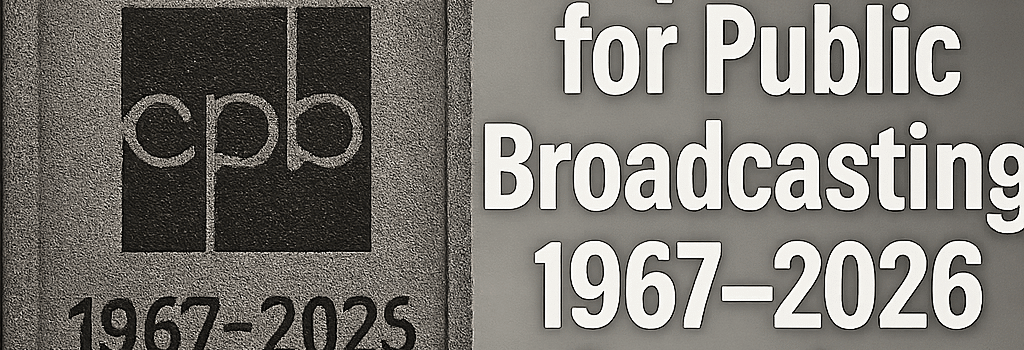RIP Corporation for Public Broadcasting: 1967–2026 Overview

After more than half a century of funding local public radio and television, the Corporation for Public Broadcasting announced in August 2025 that it will cease operations at the end of fiscal 2025. This decision follows a decisive Senate vote to strip CPB of its entire $1.1 billion appropriation for fiscal years 2026 and 2027, a move the White House characterized as ending what it called a public media grift. Despite millions of protest calls and a last-ditch fundraising effort that raised roughly twenty million dollars for NPR and PBS stations, CPB will begin winding down by September 30, 2025, with a skeleton transition team finalizing obligations by January 2026.
Historic Role of CPB in Public Media Technology
Since its founding in 1967, CPB has played a critical role not only as a grantmaker but also as a technical enabler for member stations. Early initiatives helped stations migrate from analog to stereo FM broadcasting and later introduced digital automation systems, traffic scheduling, and emergency alert integration. CPB funded the Public Radio Satellite System upgrade in the late 1990s, which replaced aging C-band uplinks with Ku-band satellite feeds and eventually supported IP-based content delivery networks. Grants for Next Generation Radio pilots tested HD Radio multicasting and datacasting services for metadata delivery and text alerts.
Budget Cuts and Shutdown Timeline
- August 1, 2025 – CPB announces wind-down following rescinded funding.
- September 30, 2025 – Majority of staff positions conclude with end of fiscal year.
- October 2025 to January 2026 – Transition team handles compliance, final distributions, music rights, and royalty agreements.
Patricia Harrison, CPB President and CEO
“Despite the extraordinary efforts of millions of Americans, we now face the difficult reality of closing our operations. We remain committed to fulfilling our fiduciary responsibilities and supporting our partners with transparency and care.”
Immediate Impact on NPR and PBS Stations
NPR President and CEO Katherine Maher warned of a cascade of effects from the shutdown. CPB provided core operating grants that covered studio maintenance, transmitter leases, and public safety interconnects. As those funds vanish, many small and rural stations face a technology gap. Engineers estimate that without federal support, at least 30 percent of low-power FM outlets will struggle to replace aging transmitters and backup generators. Stations relying on CPB grants for EAS encoding modules will have to find alternative funding to meet the FCC’s 2027 NextGen EAS requirements for CAP protocol adoption over IP.
Technical Impact on Broadcasting Infrastructure
Public broadcasting has evolved into a hybrid delivery model combining terrestrial transmitters with cloud-based streaming. CPB grants enabled stations to deploy adaptive bitrate streaming through commercial CDNs, integrate dynamic ad insertion tools, and adopt analytics platforms that measure audience engagement in real time. The loss of funding jeopardizes ongoing contracts for metadata management systems that synchronize content schedules across over 1 000 member stations. Without CPB, many entities will lose access to bulk licensing discounts for music rights, cloud storage, and SaaS playout systems.
- Cloud Transcoding and CDN Credits – CPB supplied credits to offset costs for high-volume streaming peaks during news events.
- Automation and Scheduling – Grants funded open-source tools for traffic management and RSS-based show updates.
- Digital Datacasting Trials – Research into ATSC 3.0 datacasting for IoT and community broadband bakery was underwritten by CPB.
Future of Public Media Funding Models and Cloud Migration
With federal dollars gone, experts foresee a shift toward diversified revenue streams. Membership drives and micropayments via blockchain wallets are under consideration by several NPR stations. Some innovators propose a consortium-based cloud cooperative to negotiate enterprise pricing for playout and archiving services. Others are exploring a hybrid model that pairs local underwriting with national membership platforms, similar to paywalls in digital journalism but with a nonprofit governance structure.
Stations are also investigating open standards like Synchronized Multimedia Integration Language for interactive mobile apps, hoping to repurpose existing CPB-funded R&D tools. However, engineering teams warn that without a centralized grantmaking agency, interoperability between regional networks will fragment, raising costs and raising the barrier for smaller markets to adopt advanced broadcast technologies.
Expert Opinions and Industry Response
Jane Carvalho, broadcast engineer and chair of the Society of Broadcast Engineers, commented: “The sudden removal of CPB disrupts decades of incremental technical progress. Stations will scramble to replace EAS encoders, tune RF transmitters, and secure backup power systems without bulk-purchase incentives.”
Dr. Marcus Renfield, media technology analyst at the Center for Digital Media Innovation, added: “This is more than a funding cut. It represents a strategic de-prioritization of public interest media in favor of commercial and partisan outlets. We’re likely to see consolidation around large markets, exacerbating the local news desert problem.”
The American Journalism Project, which tracks the health of local news ecosystems, issued a warning that the CPB closure could accelerate the loss of community coverage. Its report notes that 75 percent of public stations provided hyperlocal reporting or specialized cultural content made possible by CPB grants.
Conclusion
The dissolution of the Corporation for Public Broadcasting marks a watershed moment for American media infrastructure. As stations and engineers pivot toward alternative funding and peer-to-peer technology models, the nation risks losing an integrated public media system designed to serve every community, especially in emergencies. The next year will test the resilience of public broadcasters, the creativity of technologists, and the resolve of audiences to sustain a shared public service in the digital age.